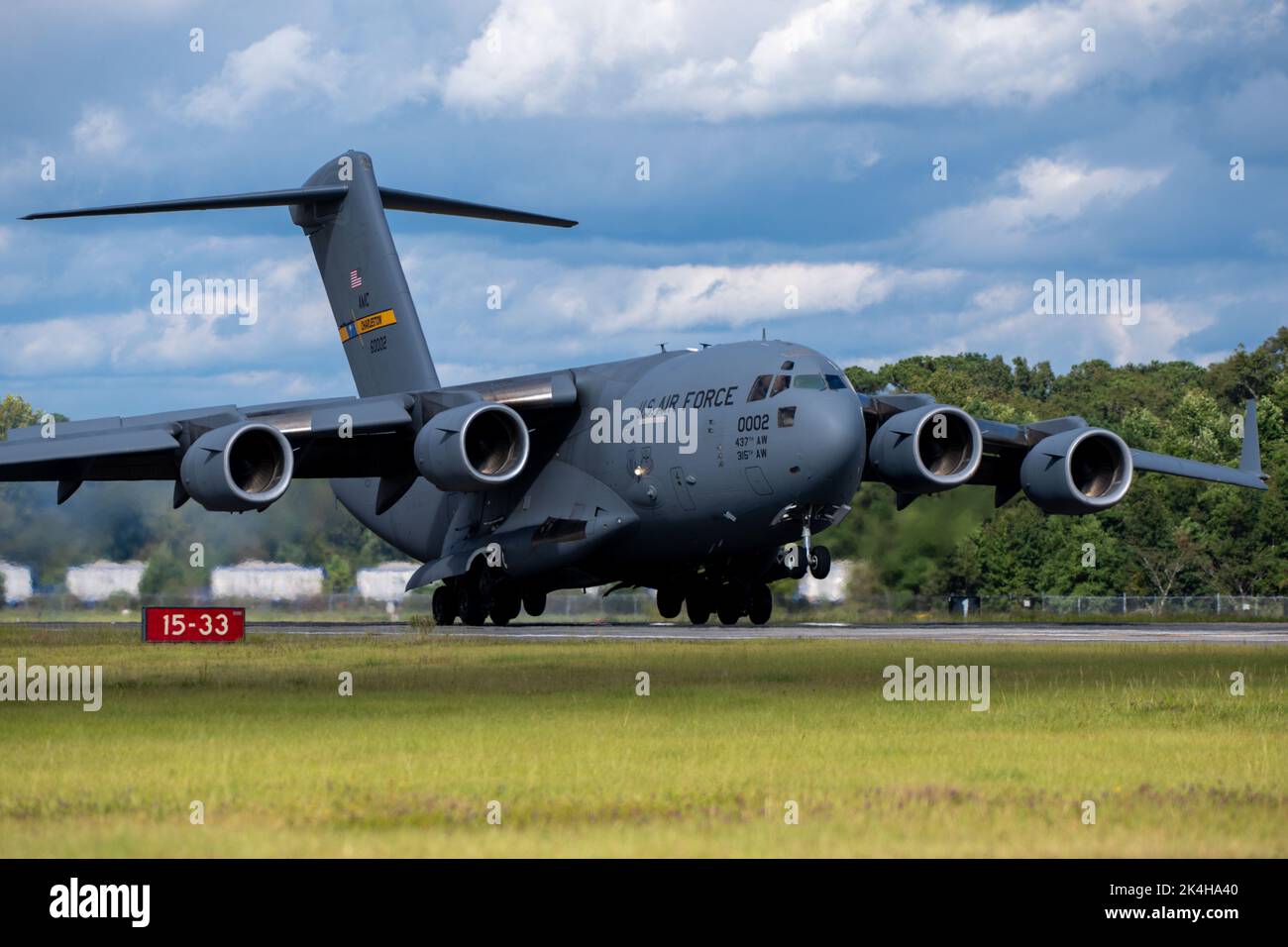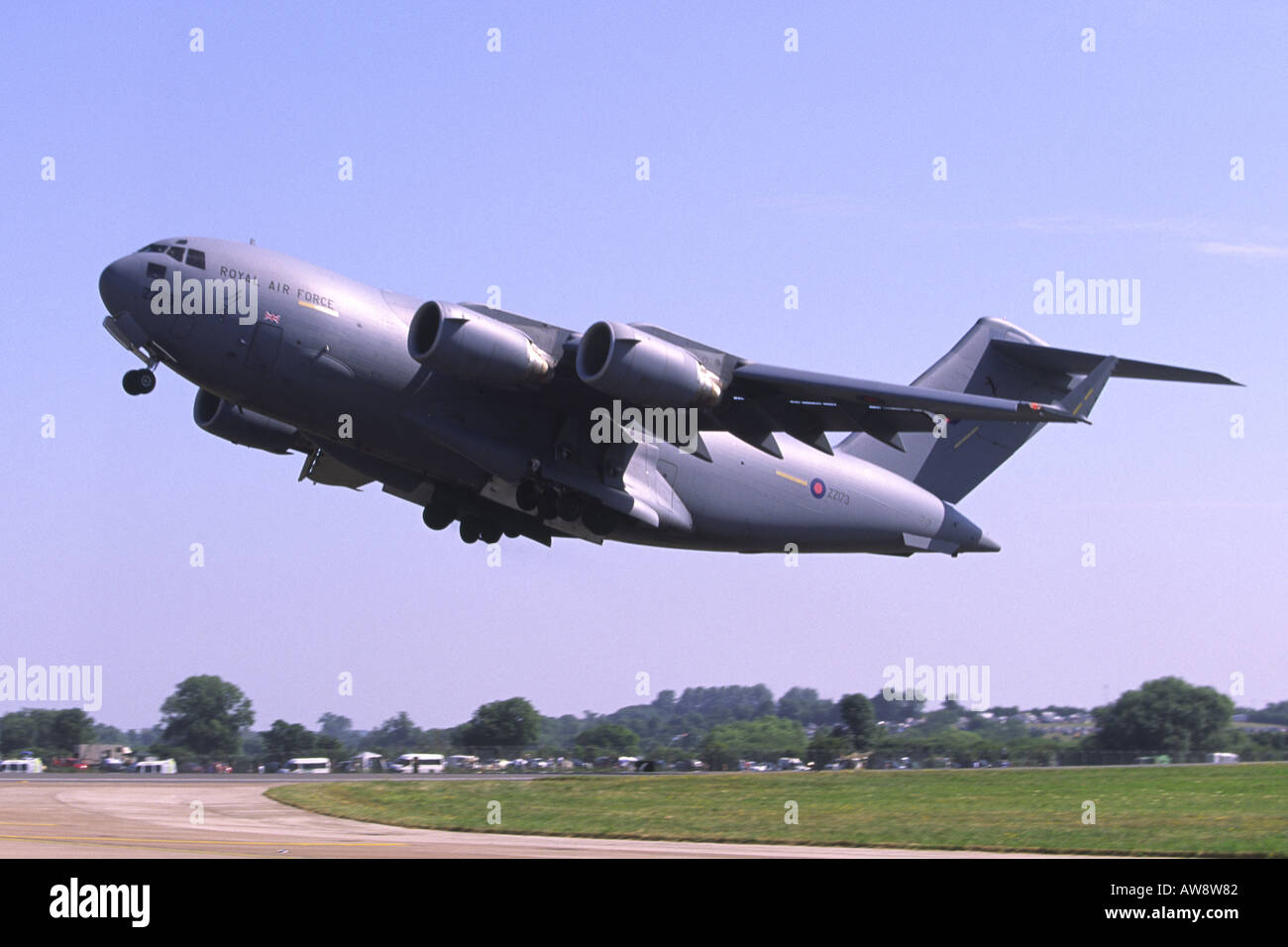C-111 Aircraft - Service: United States Air Force Propulsion: 4x Pratt & Whitney F117-PW-100 turbofan engines Speed: 450 knots Range: Worldwide with in-flight refueling Crew: 3 (2 pilots and 1 Loadmaster) Load: 102 troops/airborne troops; 36 littermates and 54 outpatients and attendants. 170,900 lb (77,519 kg) of cargo (18 pallet positions)
The C-17 Globemaster serves as the United States Air Force's primary strategic landing aircraft for the worldwide transportation of troops and equipment. The C-17 is capable of rapid and strategic delivery of troops and all types of cargo to major bases of operations or directly to forward operating bases in areas of operations. The aircraft can perform tactical airlift and airborne missions, and can transport debris and outpatients during airmedical evacuations if necessary. The inherent flexibility and capabilities of the C-17 force will enhance the capabilities of the overall airlift system to meet the global air movement requirements of the United States.
C-111 Aircraft

Reliability and ease of maintenance are two major advantages of the C-17 system. Current operational requirements place high demands on reliability and maintainability. These requirements include a 92% mission completion probability of the aircraft, only 20 aircraft maintenance man-hours per flight hour, and full and partial mission availability rates of 74.7% and 82.5%, respectively.
C 17 Globemaster Iii
Globemaster III is designed to land on narrow runways with a minimum length of 3,500 feet to 90 feet. An engine thrust reverser allows the C-17 to reverse and turn over very narrow runways on forward operational bases.
Designed as a successor to the C-141 Starlifter, the C-17 first flew on September 15, 1991, and the first production model arrived at Charleston Air Force Base, also known as Joint Base Charleston, South Carolina, in June. Delivered. The C-17's first squadron, the 17th Airlift Squadron, was declared operational on January 17, 1995.
The C-17 is operated by the Air Mobility Force at Travis Air Force Base, California. Dover Air Force Base, Delaware. Joint Base Lewis-McChord, Washington. Joint Base Charleston, South Carolina; Joint Base McGuire-Dix-Lakehurst, New Jersey
The Air National Guard flies C-17s from the 172nd Airlift Wing in Jackson, Mississippi and the 105th Airlift Wing in Stewart ANGB, New York. In addition, Air Force Material Command operates two C-17s at Edwards Air Force Base, California and Pacific Airlines. The military operates aircraft from Joint Base Elmendorf-Richardson in Alaska and Joint Base Pearl Harbor-Hickam in Hawaii.
Strategic Airlift Capability
Air Force Reserve Command operates aircraft at March Air Force Reserve Base, California and Wright-Patterson Air Force Base, Ohio. Aviation Education and Training Command has 17 aircraft at Altus Air Force Base, Oklahoma.
The Ukrainian army used self-propelled artillery to try to keep Russian troops away from Ukraine, the second largest…
Real Top Gun pilots take to the skies in F-35 fighter jets. These are the most loaded...

Ukrainian soldiers use US M777 howitzers on the battlefield to repel Russian troops...
C 17 Hangar Hi Res Stock Photography And Images
A Marine Corps plane crashed in the Southern California desert on Wednesday, killing civilians and rescue crews...
A satellite image of Ukraine's Snake Island released Friday appears to show a group of sunken Russian ships...
Conversely, the US announcement that the United States is ready to approve Abrams tanks for Ukraine is expected along with the German announcement that it will approve the Polish request…
Germany's Krauss-Maffei Wegmann, the manufacturer of the Leopard 2, calls it "the world's leading tank".
Planes From Joint Base Charleston Assisting In Afghanistan Evacuations
US and allies load Ukraine with armor and weapons ahead of expected Russian offensive, war 11 months ago, Russia active and planning, intelligence say. So we may be approaching a critical turning point...
The $2.5 billion aid will send Stryker combat vehicles to Ukraine, but not tanks. The Pentagon says the United States will send 90 Stryker combat vehicles and another 59 Bradley combat vehicles to Ukraine. ..
Strykers, Bradleys will likely be a huge US aid package to Ukraine. The C-17 is named after two previous piston military cargo aircraft, the Douglas C-74 Globemaster and the Douglas C-124 Globemaster II.

The C-17 is based on the YC-15, a small prototype airlifter designed in the 1970s. Designed as a successor to the Lockheed C-141 Starlifter, it also performs some duties for the Lockheed C-5 Galaxy. Compared to the YC-15, the redesigned Airlifter differed with swept wings, larger size and a more powerful gin. A series of design issues delayed development and cost the company nearly $1.5 billion in losses during the development phase of the program. On September 15, 1991, about a year behind schedule, the first C-17 made its flight. The C-17 was officially retired from the USAF on January 17, 1995. Boeing, which merged with McDonnell Douglas in 1997, continued to build the C-17 for nearly two decades. The last C-17 was completed at the Long Beach, California plant and flew on November 29, 2015.
Z Pu513 0297
The C-17 typically performs tactical and strategic airlift missions, transporting troops and cargo around the world. Additional roles include medical evacuation and airdrop missions. The transport aircraft is in service with the USAF, along with the heavy air transport wing, a multilateral organization based in India, the United Kingdom, Australia, Canada, Qatar, the United Arab Emirates, Kuwait and Europe. This type has provided humanitarian assistance in the aftermath of several natural disasters, including the 2010 Haiti earthquake and the 2011 Sindh floods, as well as Operation Between Freedom in Afghanistan and Iraqi Freedom in Iraq. She played an important logistical role in both operations.
In the 1970s, the United States Air Force began looking for a replacement for the Lockheed C-130 Hercules Tactical Freighter.
An AMST (Advanced Medium STOL Transport) competition was held, with Boeing proposing the YC-14 and McDonnell Douglas proposing the YC-15.
Both trantos exceeded the stated requirements, but the AMST competition was canceled before a winner was chosen. The USAF initiated the CX program in November 1979 to develop a larger, longer-range AMST to improve strategic airlift.
Lockheed Wc 130
By 1980, the USAF had a large fleet of aging C-141 Starlifter freighters. To further complicate matters, strategic airlift capabilities were required to meet the airlift requirements of its rapid deployment. The USAF established mission requirements and issued a Request for Proposal (RFP) for C-X in October 1980. McDonnell Douglas chose to develop a new aircraft based on the YC-15. Boeing has made a bid for a large three-gin version of the AMST YC-14. Lockheed submitted both a C-5 based design and a larger C-141 design. On August 28, 1981, McDonnell Douglas was chosen to produce the proposal, designated C-17. Compared to the YC-15, the new aircraft differed in having swept wings, increased dimensions and a more powerful gin.
This allows it to do the work of the C-141 and perform some missions for the Lockheed C-5 Galaxy, freeing up the C-5 fleet for oversized cargo.
After the CX competition, alternatives were pursued to meet airlift needs. These were the conversion from C-141A to C-141B, ordering additional C-5s, continuing the purchase of KC-10s, and expanding the Civil Reserve Air Force. Due to budget constraints, the program was discontinued and a four-year deferral was required. During this time, a contract was signed for the completion of preliminary design work and gin certification.
During this time, the aircraft under development received criticism and questions were raised about more cost-effective alternatives.
Video Shows U.s. C 17 Globemaster Iii Aircraft Performing Nose Gear Up Landing In Afghanistan
The first flight of the C-17 took place on September 15, 1991 from the McDonnell Douglas plant in Long Beach, California, about a year behind schedule.
The first aircraft (T-1) and five other production models (P1-P5) participated in extensive flight testing and evaluation at Edwards Air Force Base.
Static testing of the C-17 wing in October 1992 failed at 128% of design limit load and 150% below requirement. Both wings buckled from aft to front causing stringers, spars and ribs to fail.
About $100 million was spent redesigning the wing structure. In a second test in September 1993, the wing failed 145%.
Us 1:200 C 17 Transport Airplane Aircraft Globemaster Iii Aircraft With Stand
However, a review of test data showed that the wings did not load correctly and did indeed meet requirements.
In late 1993, the Department of Defense (DoD) gave contractors two years to resolve manufacturing problems and cost overruns or the contract would be terminated after delivery of the 40th aircraft.
Accepting the 1993 terms cost McDonnell Douglas nearly $1.5 billion in losses during the development of the program.

In April 1994, the program remained over budget and fell short of specifications for weight, fuel economy, payload and range. It failed several key criteria during airworthiness testing.
Squad Swap: 437th Aw Conducts Deployment Swap At Al Udeid Ab > U.s. Air Force Expeditionary Center > Article Display
In May 1994, it was proposed to reduce production to 32 aircraft. These cuts were later reversed.
According to a July 1994 Government Accountability Office (GAO) report, the 1986 and 1991 USAF and DoD studies found that outside the United States the C-17 could use 6,400 more runways than the C-5. dimensions. except Runway Strength or Load Classification Number (LCN). C-5 has
Roche cobas c 111, f-111 aircraft pictures, bac 111 aircraft, fb 111 aircraft, ram d 111 c, stabond c 111, 111 vitamin c serum, mercedes c 111, cobas c 111, mercedes benz c 111, f-111 aircraft, f 111 fighter aircraft

0 Comments